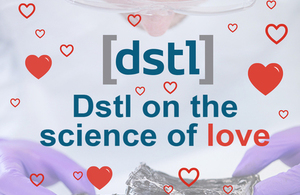Dstl experts decode the science behind falling in love
We asked our neuroscientists to explain the science of love on Valentine’s Day; Love triangles or the triangles of love?

Love is a well-studied, but little understood phenomena. Evolutionary psychology suggests that love is a way for us to attract and retain a mate enabling the reproduction and caring of offspring, but that doesn’t explain how we fall in love or what it looks like.
Psychologist and neuroscientists alike have attempted to quantify the reasons behind how we fall and stay in love; while there are many different psychological and neurological theories, love triads seem to be a common theme.
The filter theory (Kerckhoff and Davis, 1962) proposes that when we are looking to identify a suitable partner we filter down the population of potential mates based on three criteria.
Firstly, we consider social demographics; we are more likely to select a partner who has a similar background, this could be geographical closeness, closeness in social class, ethnicity or education level. When we have filtered appropriate individuals we next refine our pool based on similarity in attitudes. Finally, we apply a filter to identify complimentary characteristics, we don’t necessarily want someone who is just like us, but someone whose traits compliment ours (e.g. a creative person might come up with holiday ideas whilst their partner may be good at organising to help plan the trip).
A triangular theory of love (Sternberg, 1986) proposes that love can be understood in terms of three components; intimacy (e.g. feelings of closeness and forming bonds), passion (e.g. physical attraction and excitement) and decision/commitment (in the short-term we decide to love a partner and in the long term the commitment to maintain that love). Whilst the three components common to loving relationships, each may present differently from one relationship to another, or over time within a given relationship resulting in unique relationships.
Neuroscientists would also claim that love can be broken down into three aspects. When an individual falls in love there is an increase in the activity of brain regions that contains high concentration of dopamine which is associated with reward, desire, addition and euphoric states. Conversely, there is a decrease in activity of the amygdala, normally this is engaged during fearful situations this decrease implies a lessening of fear. Concurrently there is a decrease in frontal cortex activity resulting in a relaxed judgement.
Dstl has a wide variety of jobs for scientists, including our neuroscientists, who work on solutions for Defence and Security and for keeping people safe in the UK and abroad. If you are interested in working for Dstl look out for roles here - we are sure that you would love to work with us!